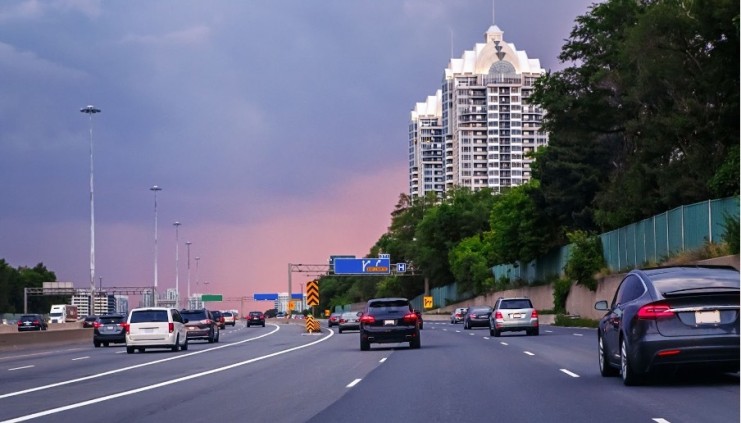The importance of road markings cannot be overstated. These seemingly simple lines on highways hold immense significance in guiding road users, directing traffic flow, and communicating essential information to drivers.
Startling statistics from the U.S. Department of Transportation reveal that nearly 95% of fatalities in our nation’s transportation networks, spanning all methods of transportation, including air travel, occur on streets, roads, and highways, underscoring the critical role of well-maintained and clear road markings.

The process of creating and maintaining these vital road markings involves complex planning, precise execution, and continuous monitoring to avoid costly mistakes in both time and money. In recent years, the convergence of technology and data-driven solutions has offered promising opportunities to revolutionize the road marking industry.
Automated systems equipped with sensors and cameras can now scan and detect existing line markings, allowing for efficient removal and replacement. On top of this, high-accuracy robotic line-marking machines are being developed to increase productivity and reduce human labor requirements. The increasing use of reflective materials enhances the visibility of road markings during night driving.
Despite these advancements, the industry has shown a degree of hesitation in fully embracing cutting-edge technologies, often opting for familiar, tried-and-tested methods.
In this article, we will examine some reasons behind this hesitation among road marking companies before exploring the challenges and concerns they face in adopting innovative approaches while shedding light on the immense benefits that await those who embrace modernization.
Evolution of Road Marking Techniques Over a Century
Over the last hundred years, the road marking process in the USA has undergone remarkable advancements. In the early days, road markings were rudimentary, consisting mainly of painted lines.
By the 1910s, several states began implementing painted lines down the centers of highways and streets to separate opposing traffic flow. California, Michigan, and Oregon were the first states to embrace painted pavement markings to denote the center of the roadway.
Since then, road marking materials and techniques have continually evolved and improved. In the 1950s, thermoplastic markings were introduced, offering better durability, visibility, and reflectivity. This was followed in the 1970s and 1980s with waterborne paints and epoxy markings, which became popular due to their environmental benefits and ease of application.
At SKIP-LINE®, we take pride in leading the way during this period of progress and innovation.
In 1969, founder Vic Shinsel, keenly observed the challenges faced by the La Grande, Oregon Department of Transportation road-marking crew while attempting to mechanically adjust a skipping pattern. Determined to find a solution, Vic, an enthusiastic inventor, designed the world’s first electronic controller for road markings, aptly named the “skip timer.” This invention quickly gained popularity across North America, revolutionizing the road marking process and setting a new standard for efficiency and precision.
Risks of Maintaining Traditional Approaches
Despite significant technological advancements within the road painting industry, some companies have been hesitant to fully embrace cutting-edge technologies, instead relying on tried and tested methods.
This cautious approach is understandable, given road markings’ critical role in road safety. Moreover, many of these companies have achieved commendable success with a traditional mindset, operating without heavy reliance on modern technology. However, maintaining such an approach carries inherent risks that could compromise long-term efficiency and profitability.
For instance, some road marking companies still manage their inventory by physically inspecting paint tanks and using a dipstick to calculate the amount of paint left.
Unfortunately, this manual method introduces errors and inaccuracies, leading to the potential overapplication of paint to meet specific thickness requirements, resulting in wasteful spending of resources and time. On the flip side, applying paint too thinly may lead to failure in meeting required specifications, necessitating costly remarking of the roads.
Introducing the SKIP-LINE System: A Comprehensive Solution
Adopting modern technologies in the road painting industry can address these challenges. For instance, the complete SKIP-LINE system and technology offer comprehensive visibility into the entire operation.
While typical trucks have basic “skip-timer” systems that control the paint guns, the limited functionality of these traditional systems restricts their capabilities to basic automation. In contrast, the SKIP-LINE system offers a comprehensive suite of advanced features that go well beyond simple turn switches for controlling the paint guns and applying paint on the ground.
The SKIP-LINE system provides a wide range of equipment and service capabilities, including:
- High-definition video guidance and material monitoring platforms
- Full specification data logging equipment
- Retro-reflectivity testing services
- Markings inventory and imagery
- Complete cloud-based pavement markings management software platform.
Skip-Line’s equipment and services enable the user to capture, visualize and manage all aspects of the operation, ranging from material use, application metrics and marking performance.
Through a combination of vehicle-mounted mobile equipment and portable handheld units, SKIP-LINE can capture retro-reflectivity data of all markings on the highway network. This data, analyzed and reported with GPS reference points for location, allows for better decision-making in asset management.
SKIP-LINE can also simultaneously collect data on the type, location, and quantity of markings, including condition assessments and reflectivity levels.
Access to such real-time data allows for more effective analysis and assessment of each job, leading to improved efficiency, reduced waste, and enhanced overall performance. By embracing innovative technologies like SKIP-LINE, road marking companies can ensure better results, higher safety standards, and a more profitable and sustainable future for the industry.
Embracing the Future: A Safer Road Ahead
The road marking industry has come a long way, evolving from basic painted lines to the introduction of more durable and visible thermoplastic markings and waterborne paints.
While roadmarking companies’ cautious approach toward embracing cutting-edge technologies is understandable, it is crucial to recognize the potential risks associated with maintaining traditional methods. By adopting such advanced solutions, like those offered by SKIP-LINE, road marking companies can streamline operations, reduce wastage, and ultimately create safer roads for all road users.
Contact us today to learn how our cutting-edge solutions can streamline your operations and enhance road safety.

